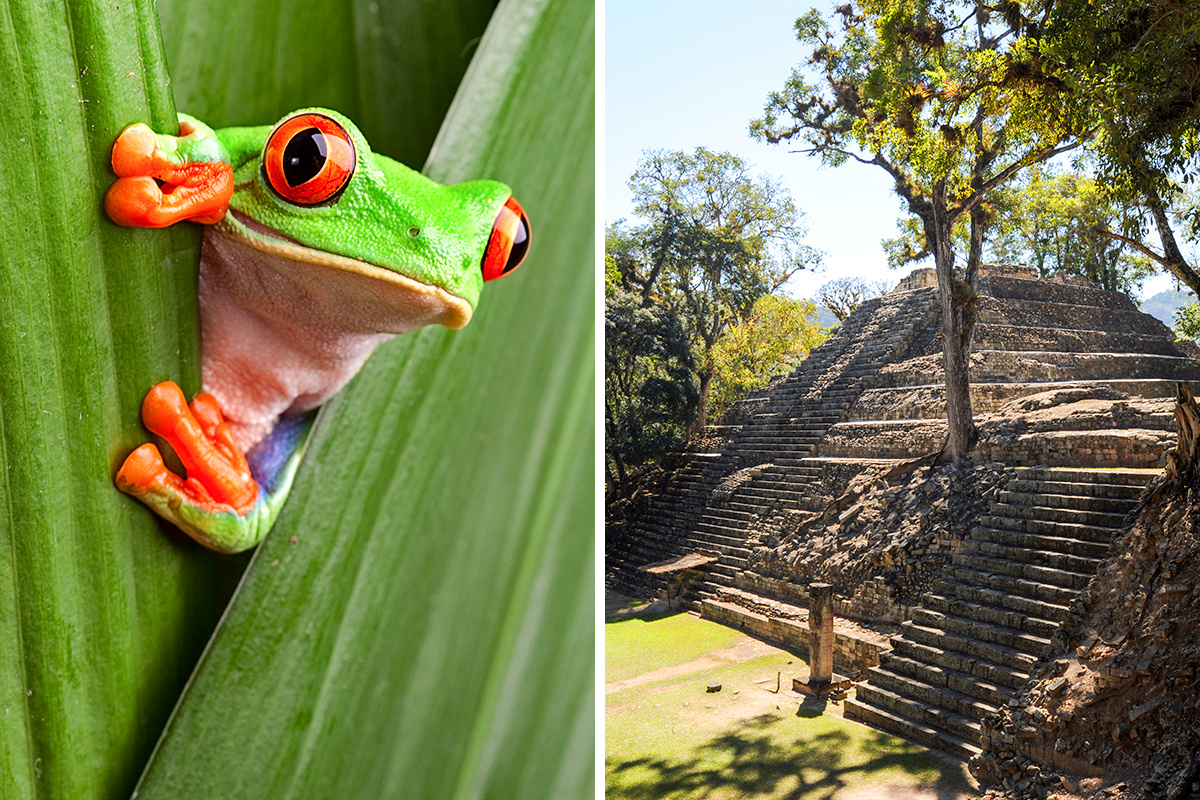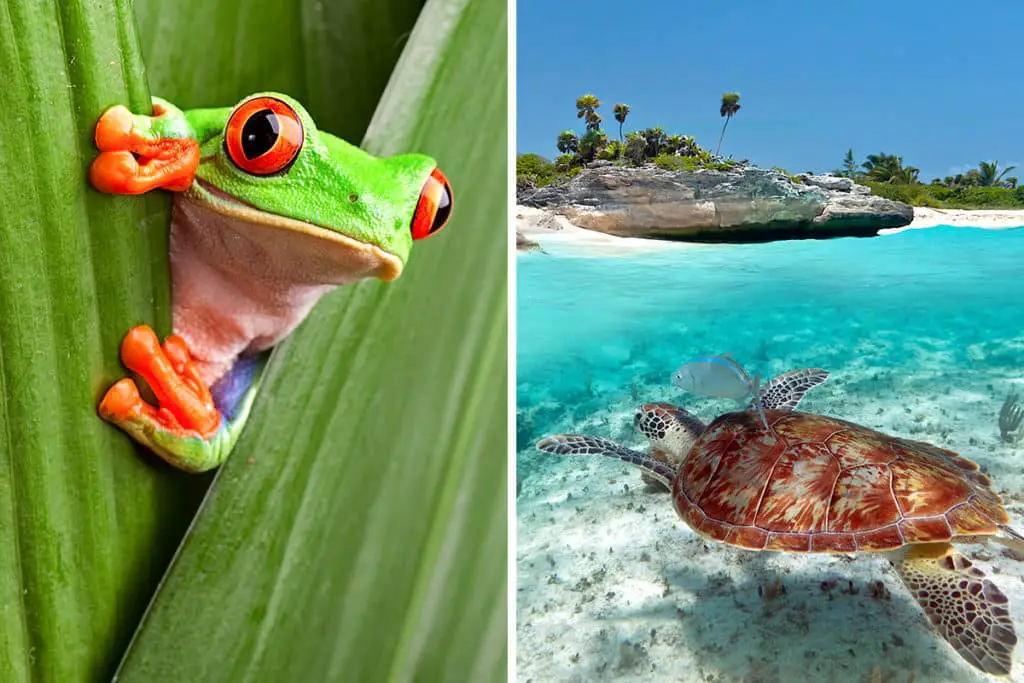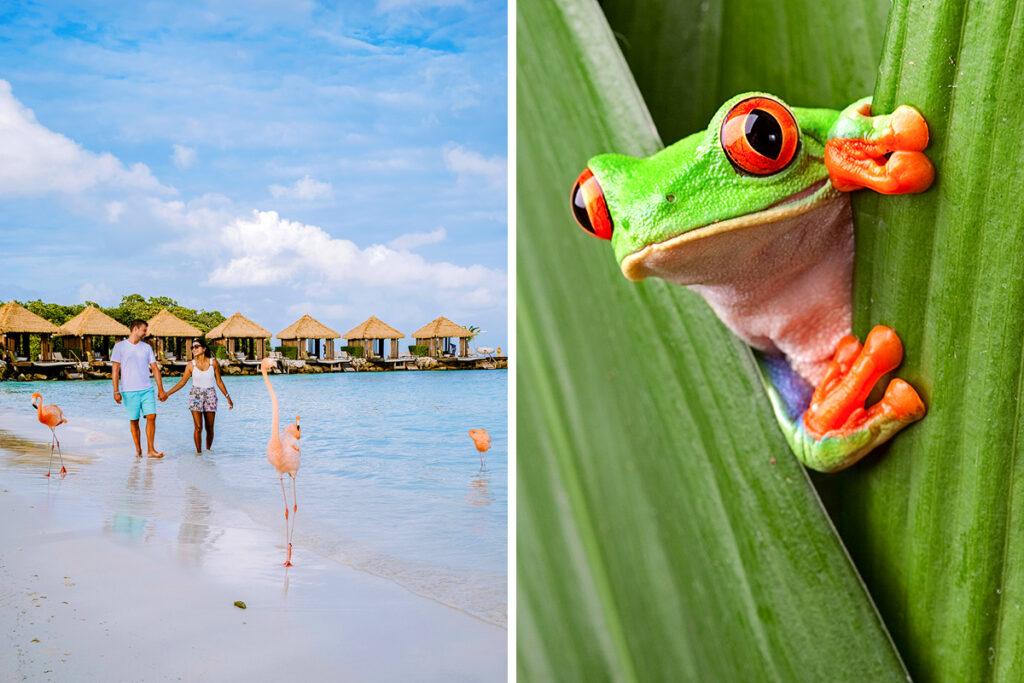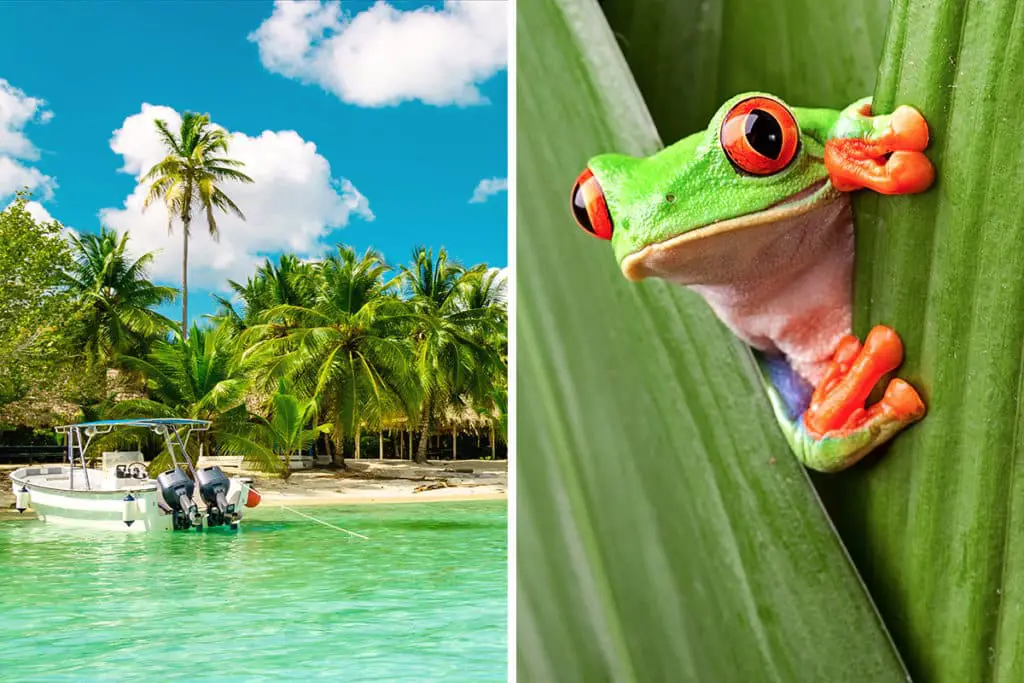In this comparison, we’ll delve deeper into what each country has to offer, from their rich history and culture to the variety of activities and attractions available. By the end of this comparison, you’ll be better equipped to choose the destination that best aligns with your travel goals and desires. So let’s dive in and explore Costa Rica and Honduras!
History & Culture
When exploring the history and culture of Costa Rica and Honduras, you’ll find that each country has its own unique story to tell. Rich cultural heritages and fascinating historical backgrounds await your discovery in both destinations.
Costa Rica’s history is deeply rooted in its indigenous people, with influences from the Spanish colonization in the 16th century. The country is known for its emphasis on peace and democracy, abolishing its army in 1949.
In contrast, Honduras was once home to the mighty Maya civilization, leaving behind impressive ancient ruins to explore. Its history has also been shaped by Spanish colonial rule and political unrest in the 20th century.
In terms of culture, Costa Rica is a melting pot, with influences from indigenous, Spanish, and Afro-Caribbean traditions. This diversity is reflected in their vibrant music, dance, and festivals, such as the popular Fiestas de los Diablitos.
On the other hand, Honduras showcases a blend of indigenous, Spanish, and African cultures. Traditional Garifuna music and dance, for example, reflect the nation’s diverse cultural heritage.
Costa Rican art is known for its colorful and intricate craftsmanship, with traditional oxcarts and wooden masks being notable examples. Honduran art, in contrast, is heavily influenced by its Mayan heritage, with pottery and stone sculptures showcasing their ancient artistic prowess.
When it comes to languages, Spanish is the official language in both Costa Rica and Honduras. However, in Costa Rica, you may also encounter indigenous languages, while Honduras has a more diverse linguistic landscape, including Garifuna and several Mayan languages.
In summary, both Costa Rica and Honduras boast rich histories and diverse cultures. Costa Rica’s peaceful past and cultural fusion create a vibrant atmosphere, while Honduras offers a fascinating glimpse into ancient Maya civilization and a mix of cultural influences.
Attractions & Activities
Costa Rica and Honduras are packed with exciting attractions and activities, offering something for every traveler. While there’s plenty to see and do in both countries, each destination has its own unique appeal.
In Costa Rica, you can embark on an eco-adventure, exploring lush rainforests teeming with diverse wildlife. Activities like zip-lining, bird-watching, and hiking through national parks, such as Manuel Antonio and Monteverde Cloud Forest Reserve, provide thrilling experiences for nature enthusiasts.
Honduras, on the other hand, is home to captivating ancient ruins that transport you back in time. The famous Mayan city of Copán is a must-visit for history buffs, featuring intricate stone carvings and impressive architecture.
For adrenaline-seekers, Costa Rica’s white-water rafting and volcano tours, like Arenal Volcano and Poás Volcano, promise unforgettable thrills. Meanwhile, Honduras offers adventure in the form of exploring its vast network of caves, such as the Talgua Caves, where you can marvel at shimmering crystal formations.
If you’re looking for relaxation, both countries provide opportunities to unwind in natural hot springs. Costa Rica’s La Fortuna and Tabacon Hot Springs are popular choices, while Honduras’ Luna Jaguar Hot Spring offers a serene escape.
In addition to these activities, Costa Rica is renowned for its eco-tourism and conservation efforts, allowing you to witness the beauty of the natural world firsthand. Conversely, Honduras boasts the second-largest barrier reef in the world, making it a dream destination for scuba diving and snorkeling enthusiasts.
In conclusion, both Costa Rica and Honduras offer an array of attractions and activities catering to different interests. From eco-adventures in Costa Rica’s rainforests to exploring ancient Mayan ruins in Honduras, your choice will depend on the type of experiences you seek.
Beaches
When considering a tropical getaway, the quality of beaches can be a deciding factor. Both Costa Rica and Honduras boast stunning coastlines, but each offers unique beach experiences.
Costa Rica is famous for its diverse and picturesque beaches along both the Pacific and Caribbean coasts. The Pacific side features popular spots like Manuel Antonio and Tamarindo, where you can enjoy warm sand and exciting water sports. On the Caribbean coast, you’ll find more laid-back vibes and pristine sands in places like Puerto Viejo and Cahuita.
In contrast, Honduras is known for its breathtaking Caribbean coastline, especially around the Bay Islands. Roatán, the largest island, is home to West Bay Beach, where you can relax on white sand and explore vibrant coral reefs just a short swim from the shore. Utila and Guanaja also offer idyllic beach experiences, with unspoiled natural beauty.
For surf enthusiasts, Costa Rica’s Pacific coast provides excellent waves, particularly in Dominical and Santa Teresa. Honduras, on the other hand, is less known for surfing but still offers some opportunities, especially around the Tela area.
If you’re seeking seclusion, both countries have hidden gems. Costa Rica’s Corcovado National Park boasts remote beaches, while Honduras’ Cayos Cochinos provides a tranquil escape away from the crowds.
In terms of accessibility, Costa Rica’s beaches are generally easier to reach, with many located near tourist hubs. Honduras’ beaches, particularly those on the Bay Islands, may require extra travel, such as flights or boat rides.
In summary, both Costa Rica and Honduras offer beautiful beach experiences with unique characteristics. Costa Rica’s diverse coastline caters to various interests, while Honduras provides a Caribbean paradise, particularly in the Bay Islands.
Eating, Drinking & Nightlife
The culinary scene and nightlife are essential aspects of any vacation. Costa Rica and Honduras both have something to offer in terms of eating, drinking, and evening entertainment.
Costa Rican cuisine is known for its fresh and flavorful dishes, featuring staples like gallo pinto (rice and beans) and casado (a traditional meal with rice, beans, and meat). In Honduras, you’ll find similar ingredients but with distinct local twists, such as baleadas (a tortilla filled with beans, cheese, and other toppings) and sopa de caracol (a hearty conch soup).
As for drinking, Costa Rica is famous for its coffee, grown in the highlands and served in local cafés. You can also enjoy refreshing natural fruit drinks, called refrescos. In Honduras, you’ll find a range of local beers, such as Salva Vida and Port Royal, as well as tropical cocktails featuring Honduran rum.
When it comes to nightlife, Costa Rica offers a variety of options, from lively bars and clubs in tourist hubs like San José and Jacó to more relaxed beachside hangouts in Tamarindo and Puerto Viejo. In Honduras, the nightlife is generally more low-key, with beach bars and live music venues in places like Roatán and La Ceiba.
If you’re looking for a fine dining experience, Costa Rica has a wider selection of upscale restaurants, particularly in San José and major tourist areas. In Honduras, you’ll find a smaller but growing fine dining scene, especially in Tegucigalpa and Roatán.
Both countries also offer vibrant local markets where you can sample traditional street food, such as Costa Rica’s ferias or Honduras’ mercados.
To sum up, Costa Rica and Honduras each provide unique culinary experiences and nightlife options. Costa Rica boasts a diverse range of dining and entertainment choices, while Honduras offers a more laid-back atmosphere with Caribbean flavors and beachside venues.
Shopping
Shopping can be an enjoyable part of any vacation, and both Costa Rica and Honduras offer unique opportunities for retail therapy.
In Costa Rica, you’ll find a mix of local markets, artisan shops, and modern shopping malls. The Central Market in San José is a popular spot to buy souvenirs, such as hand-painted oxcarts and leather goods. For more upscale shopping, you can visit malls like Multiplaza Escazú and Avenida Escazú in the capital city.
Honduras also has a variety of shopping options, with local markets and artisan shops selling traditional crafts, such as Lenca pottery and Garífuna woodcarvings. In cities like Tegucigalpa and San Pedro Sula, you’ll find modern malls, like Mall Multiplaza and City Mall, offering international brands.
If you’re interested in eco-friendly and sustainable products, Costa Rica has a strong focus on supporting local artisans and environmentally responsible products. You can find numerous stores and markets offering such items throughout the country.
Honduras, while not as focused on eco-friendly products, still has opportunities to support local artisans. La Casa de las Ónix in Copán Ruinas, for example, sells unique jewelry and sculptures made from locally sourced onyx.
In terms of accessibility, Costa Rica’s shopping scene is generally more tourist-friendly, with many options close to popular destinations. Honduras’ shopping opportunities are more spread out and may require extra effort to locate unique finds.
In conclusion, both Costa Rica and Honduras offer enjoyable shopping experiences, with a mix of local markets, artisan shops, and modern malls. Costa Rica has a stronger focus on eco-friendly and sustainable products, while Honduras provides a more authentic local shopping experience.
Accommodation
Finding the right place to stay is essential for a memorable vacation. Costa Rica and Honduras both offer a range of accommodation options to suit different tastes and budgets.
Costa Rica is known for its diverse lodging choices, from luxury eco-lodges and all-inclusive resorts to budget-friendly hostels and vacation rentals. Popular tourist destinations, like Manuel Antonio and Tamarindo, have numerous options to choose from.
In Honduras, you’ll also find a variety of accommodations, including beachfront resorts, boutique hotels, and budget hostels. The Bay Islands, such as Roatán and Utila, are particularly popular for their range of lodging options.
For unique stays, Costa Rica offers treehouses, glamping sites, and sustainable eco-lodges, often located in stunning natural settings. Honduras has some unique options as well, like staying in a Garífuna village or an eco-lodge in the jungle.
Both countries provide accommodations that cater to different interests, such as wellness retreats, surf camps, and adventure lodges.
In terms of accessibility, Costa Rica’s accommodations are often easier to book and closer to popular attractions. In Honduras, while there are still many options, they may require more research and effort to find the perfect fit.
To sum up, both Costa Rica and Honduras offer a variety of accommodation options to suit different preferences and budgets. Costa Rica boasts a more diverse range of unique and eco-friendly stays, while Honduras provides a more authentic experience with a focus on local culture.
Family-Friendliness & Children’s Activities
When planning a family vacation, it’s important to consider destinations that offer fun activities for children. Costa Rica and Honduras both have options for families, but let’s see how they compare.
In Costa Rica, there’s an abundance of family-friendly activities, such as wildlife watching in Monteverde Cloud Forest, zip-lining in Arenal, and visiting the La Paz Waterfall Gardens. Beaches like Manuel Antonio and Tamarindo have calm waters, making them ideal for kids to swim and play.
Honduras also offers activities for families, like exploring the Copán Ruinas archaeological site, swimming with dolphins in Roatán, and visiting the Macaw Mountain Bird Park & Nature Reserve. However, the options may be more limited compared to Costa Rica.
Costa Rica has a well-established tourism infrastructure, which means more organized tours and kid-friendly facilities, such as playgrounds and family-oriented restaurants. Safety is also a priority, with many activities designed with children in mind.
In Honduras, while there are family-friendly options, the tourism infrastructure may not be as developed. This can make planning and finding child-friendly facilities more challenging.
In conclusion, both Costa Rica and Honduras have family-friendly activities, but Costa Rica offers a broader range of options and a more developed tourism infrastructure. This makes it a more attractive destination for families with children.
Getting There & Getting Around
Considering how to reach and navigate your vacation destination is crucial for a smooth trip. Let’s compare Costa Rica and Honduras in terms of transportation.
To get to Costa Rica, you can fly into one of two international airports: Juan Santamaría International Airport (SJO) near San José or Daniel Oduber Quirós International Airport (LIR) near Liberia. Direct flights are available from many major cities in North America and Europe.
Honduras also has two international airports: Ramón Villeda Morales International Airport (SAP) in San Pedro Sula and Toncontín International Airport (TGU) in Tegucigalpa. However, there may be fewer direct flights from major cities, making travel to Honduras slightly more challenging.
In Costa Rica, getting around is relatively easy, with options like car rentals, buses, and shuttle services. Roads are mostly in good condition, but driving in rural areas can be challenging due to poor signage and rough terrain.
Honduras has a less developed transportation infrastructure, with fewer rental car options and less reliable public transportation. Additionally, road conditions can be poor, making driving more difficult.
In summary, Costa Rica has better transportation options and infrastructure, making it easier to get there and travel within the country. While Honduras also offers various transportation options, the infrastructure is less developed, which can make getting around more challenging for visitors.
Weather
When planning a vacation, weather can play a significant role in your experience. Let’s compare the climate in Costa Rica and Honduras to help you choose the right destination.
Costa Rica has a tropical climate with two distinct seasons: the dry season from December to April and the rainy season from May to November. Temperatures are generally warm, averaging around 70-81°F (21-27°C) in the highlands and 89-95°F (32-35°C) in the coastal areas.
Honduras also has a tropical climate, but its dry season is shorter, lasting from November to April. The rainy season occurs from May to October. Temperatures in Honduras are similar to those in Costa Rica, with averages of 68-86°F (20-30°C) in the highlands and 90-100°F (32-38°C) along the coast.
Both countries have ideal weather for beach vacations, but if you prefer less rain, Costa Rica’s dry season offers more months with little precipitation. Keep in mind that the weather can vary depending on the region you visit in either country.
Safety
Ensuring a safe and enjoyable vacation is important, so let’s compare the safety of Costa Rica and Honduras.
Costa Rica is considered one of the safest countries in Central America for tourists. Petty crime, like pickpocketing and bag-snatching, can occur, but taking basic precautions can help minimize risks. Overall, Costa Rica has a lower crime rate compared to other countries in the region.
Honduras has a higher crime rate, with issues like theft and street crime being more prevalent, especially in larger cities like Tegucigalpa and San Pedro Sula. However, tourist areas are generally safer, and most visitors do not encounter any issues.
In both Costa Rica and Honduras, it is essential to exercise caution, avoid displaying valuables, and stay in well-traveled areas. As for unique concerns, natural hazards like earthquakes and tropical storms can affect both destinations, so it’s wise to stay informed about local conditions during your visit.
In conclusion, Costa Rica is generally safer for tourists, but with proper precautions, you can have a secure and enjoyable trip in either country. Be aware of your surroundings and follow safety guidelines to ensure a memorable vacation.
Cost
Budget is a crucial factor when planning a vacation. Let’s compare the costs of traveling to Costa Rica and Honduras to help you make an informed decision.
Costa Rica is a more expensive destination than Honduras. Meals in Costa Rica can cost around 3,500-7,000 CRC (6-12 USD), while accommodations range from 30,000-100,000 CRC (50-170 USD) per night, depending on the location and amenities. Transportation, such as renting a car or using buses, can also add to your expenses.
In contrast, Honduras offers more budget-friendly options. You can find meals for 70-140 HNL (3-6 USD) and accommodations for 600-3,000 HNL (25-125 USD) per night. Transportation costs are generally lower than in Costa Rica as well.
When it comes to attractions, both countries have free and paid options. In Costa Rica, entry fees for national parks and reserves can cost between 5,000-15,000 CRC (8-25 USD). In Honduras, you can expect to pay around 240-480 HNL (10-20 USD) for similar attractions.
Overall, Honduras is a more affordable destination for travelers on a tight budget. However, Costa Rica offers a wider variety of accommodations and experiences, which may justify the higher costs for some visitors.
Which Is Better – Costa Rica or Honduras?
In conclusion, both Costa Rica and Honduras have unique offerings that cater to different types of travelers. Here’s a summary of each destination based on the various factors discussed.
Costa Rica boasts a rich history and culture, with diverse attractions and activities for visitors to explore. Its beaches are perfect for relaxation, while its dining scene offers a variety of culinary experiences.
Costa Rica is known for being family-friendly and safe, with a well-developed transportation network. The weather is ideal for outdoor activities, but be prepared for higher costs compared to Honduras.
Honduras, on the other hand, is a budget-friendly alternative with a vibrant history and culture. Its attractions and activities cater to travelers seeking adventure and natural beauty. While its beaches may not be as renowned as Costa Rica’s, they still provide a relaxing escape.
Honduras has a more limited dining scene, but it is still worth exploring for its local flavors. Family-friendly options are available, but safety concerns should be considered when planning your trip. The weather is similar to Costa Rica’s, with a shorter dry season.
In summary, choose Costa Rica if you’re looking for a safer destination with a wide range of attractions, activities, and accommodations. It is an ideal choice for families and those willing to spend more for a memorable experience.
On the other hand, Honduras is an excellent option for budget-conscious travelers seeking cultural immersion and adventure. While safety concerns should be considered, with proper precautions, Honduras can provide a unique and unforgettable vacation.







